|
Former Seattlites are
Reinventing Themselves in the Hills of San Miguel
By
Carol Pucci,
Seattle Times
July
28, 2008
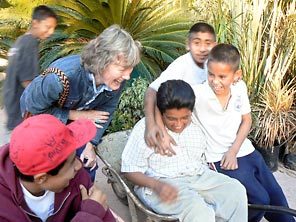
Former Bainbridge Island resident Margo Lane greets neighbor boys in a park near her home in San Miguel de Allende. Retired Americans like Lane are making a comfortable, fulfilling new life here in the hills of central Mexico.
It's Friday night at Bella Italia, and if it weren't for the smell of corn roasting on a sidewalk grill and the mariachis singing in the town square a block away, you might think this crowded Italian restaurant tucked behind stone walls in an outdoor courtyard was somewhere in Rome — not in San Miguel de Allende, a desert town deep in the heart of Mexico.
Lights strung across the trees flicker in the warm breeze as waiters uncork bottles of Chianti and deliver plates of fresh mozzarella, salami and roasted peppers. At a table near the bar, a group from Seattle polishes off platters of roasted duck as jazz trumpeter and Oregon native son Doc Severinsen takes the stage.
Looking much younger than 81 in his bluejeans and white shirt, he's packed the house as he always does when he leaves his retirement retreat in the hills above town to jam with a local Mexican band.
"There's an old saying," says Larry Sands, a former advertising executive from Tacoma, glancing at a group of silver-haired women shimmying and swaying at the next table over.
"People go to Florida to die. People come to San Miguel to live."
LEONA CAMP steers her Toyota SUV off the highway and onto a dirt road a few miles from Mega Foods, the Mexican version of Wal-Mart, where she does her weekly shopping.
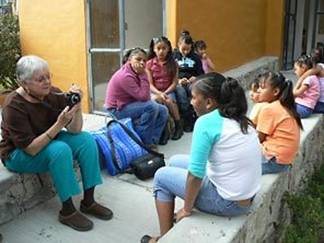 Left:
Leona Camp volunteers her time taking photos at Casa Hogar Santa Julia, a home for girls run by Catholic nuns in San Miguel. She recently photographed a birthday party for the home's youngest resident, 1-year-old Paulina, whose mother is an alcoholic. Left:
Leona Camp volunteers her time taking photos at Casa Hogar Santa Julia, a home for girls run by Catholic nuns in San Miguel. She recently photographed a birthday party for the home's youngest resident, 1-year-old Paulina, whose mother is an alcoholic.
There's a birthday celebration planned for 1-year-old Paulina, the youngest resident at Casa Hogar Santa Julia, a home run by Catholic nuns for girls whose families can't or won't care for them. Dressed comfortably in a T-shirt, turquoise cotton pants and clogs, Camp sprints
around the dining room, taking pictures of the girls in party hats and masks helping Paulina blow out the single Mickey Mouse candle on her cake.
Volunteer photographer is just one of the new jobs this grandmother of six and former nurse has taken on since she and her husband, Gerry, retired in Mexico 2 ˝ years ago. She helps manage a bookstore at the public library, leads Sunday house and garden tours and, although she'd never written before, reports for the local bilingual newspaper.
Now in their late 60s, the Camps sold their home in Northern California and keep only an apartment in their daughter's basement in Seattle. For them and others who left family and friends behind to settle here in the mountains of Central Mexico, retirement is less about finding a sunny, cheap place to live than it is about joining a community where people thrive on the idea of starting life anew.
Gerry, a former English teacher who loved acting, now directs plays for a community theater group and teaches English and math online at his kitchen computer.
"There's something about San Miguel and the people who wind up here," says Leona Camp. "People reinvent themselves."
What drives people to pull up roots and move to a foreign country, not as footloose backpackers but as aging adults with children, homes, the usual medical concerns and a lifetime of possessions?
Economics, certainly. With property taxes of just around $90 last year on a new $300,000, 3,500-square-foot stone-and-stucco retreat overlooking a lake, the Camps live on $2,500 a month in Social Security payments.
They take moonlight swims in their lap pool, and the nearly year-round springtime weather means Leona no longer has to take allergy shots or as much asthma medicine. But what really keeps them here, they say, are the kinds of people they now call friends. There's an American neighbor who makes and plays Japanese-style flutes; a writer and artist who lived with the Dalai Lama for 17 years; a conservative couple from Texas with whom they watched election results on Super Tuesday, and the young female Mexican architect who worked on their home.
Sitting on the couch in a living room decorated with art they brought back from their five years in Spain, Leona starts to cry when she talks about the time the family spent together in San Miguel more than 30 years ago. She and Gerry, who grew up in Spokane, brought their four children here in an RV in 1974 to live for three months while he was on sabbatical.
A man delivered wood to their house on the back of a burro so Gerry could build a fire to heat water. The Hotel La Siesta trailer park where they camped the first night is still around.
"When we came back here," says Leona, "it felt like we were coming home."
One daughter still can't understand their decision to live in a country many Mexicans try to escape. It's a subject that comes up when they return to Seattle to see doctors, not because they can't find good care in San Miguel (doctors here still make house calls), but because Medicare doesn't cover them in Mexico. In an emergency, they'd have to pay out of pocket. "And if it was really expensive," says Leona, "we'd have to put it on our Visa or sell the house, because we have no savings."
It's a risk they decided to take.
On a recent driving trip back to the U.S., they played a game called "Goin' Back."
"Along the way we would pull into different towns and say, 'Well, here's a place where we could retire. It was awful. Yuma (Arizona) was the worst. Just RVs and trailers . . . sit around and talk and start happy hour early. That's just not for us."
NINE HOURS' drive from the ocean, San Miguel de Allende sits like a Tuscan hill town more than a mile above sea level, surrounded by mountains in the Bajio, Mexico's heartland, known for its postcard views and colonial architecture, the work of Spanish conquistadors who mined for silver here in the 1500s.
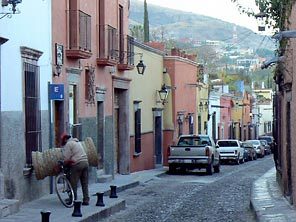
Downtown San Miguel de Allende was declared a national monument in 1926, keeping the area free of neon signs and traffic lights. Just recently, the United Nations named it a World Heritage site.
Its preserved historical core, El Centro, looks much the way it has since it was declared a national monument in 1926. All around are elaborate churches, gardens and fountains. A patchwork of low-rise stucco buildings line narrow, cobblestone streets free of neon signs and traffic lights but not traffic — the result of a boom that has turned San Miguel into a popular destination for Mexican as well as foreign tourists.
Ex-pats have been coming here since American Sterling Dickinson founded an art school, now the Instituto Allende, in the 1930s. The mixing of cultures has created a unique bicultural arts scene. Notices of literary workshops, theater performances, jazz festivals and chamber-music concerts fill several pages in the paper each week.
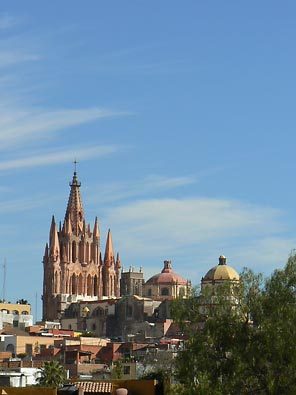
With the exception of the original religious buildings, all buildings in San Miguel's historic center are limited to two stories, creating a skyline dominated by steeples, towers and domes. The Gothic-style church called La Parroquia is the town's most famous landmark.
"It reminds me very much of when I was in college," says Bainbridge Island landscape designer David Lewis. He and his partner, artist George Little, recently bought their second house in San Miguel, a 3,500-square-foot colonial in El Centro with a swimming pool and view of La Parroquia, the town's Gothic-style cathedral. New York Magazine called San Miguel "the closest thing Mexico has to Florence," a description that might surprise those who think of Mexico as either touristy beach resorts or dusty villages where you can't drink the water, eat the food or get by without speaking Spanish.
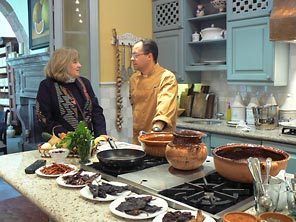 Left:
Camie Sands, a former Tacoma advertising executive, runs a tour company in San Miguel, a town she says was "always sitting there as this perfect little spot," ever since she first visited as a girl when her uncle moved there and married a Mexican woman. Above, she discusses arrangements for a cooking class with Fernando Padilla. Left:
Camie Sands, a former Tacoma advertising executive, runs a tour company in San Miguel, a town she says was "always sitting there as this perfect little spot," ever since she first visited as a girl when her uncle moved there and married a Mexican woman. Above, she discusses arrangements for a cooking class with Fernando Padilla.
Larry Sands for years refused to visit the town his wife, Camie Sands, says was "always sitting there as this perfect little spot" ever since the first time she visited as a young girl after her uncle moved to San Miguel and married a Mexican woman.
"I had no desire," says Sands, 65, "because I'd been to Mexico," meaning Cancun, and decided that the flipflops-and-margarita scene was not for him. But after Camie Sands returned from a visit with news that she'd bought property as a 40th-birthday present to herself, he agreed to give it a try.
"I got here and I thought, 'I'm in Europe.' It put a spark in me, I guess," and it wasn't long thereafter that they put a 10-year retirement on fast-forward, rented out their home in Tacoma, and moved to San Miguel, leaving behind family, including his two adult children and two grandchildren.
Eight years later, they're in their second house — a $300,000, two-level home with a rooftop deck on the edge of El Centro where they live with their four dogs, two cats and a parrot.
They pay a part-time housekeeper $80 a week, an affordable luxury that allows them to pursue new part-time second careers. Camie, 52, is directing this year's Chamber Music Festival, publishes a walking and shopping guide and runs a company called Simply San Miguel that specializes in custom tours. Larry Sands recently built two rental houses and formed a business helping people troubleshoot construction jobs.
The grandchildren visit during the summer. Most of their friends are other Americans, but they're hoping their network of Mexican friends expands as their Spanish improves. Apart from trying to learn the language, Larry says the hardest part was overcoming his perceptions not only about Mexico but also about Mexicans.
"You'll see the young men with their tight bandannas, walking down the street, scowling . . . I just kept trying . . . saying 'Buenos dias. Come está?' and they lightened up. That was a big thing for me."
TONY COHAN, the author of "On Mexican Time," a book chronicling his and his wife's move from California to San Miguel, quotes a friend as posing this question in the mid-1980s:
"San Miguel has no surf, no nightlife, no airport . . . There are three television channels in Spanish with bad reception. There aren't enough phone lines or water. How popular can a town like this become?"
Two decades later, the answer lies behind stucco walls and wooden doors where hidden courtyards lead to stunning, million-dollar homes in buildings where three or four Mexican families once lived.
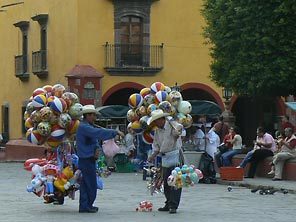 Left:
Community life in San Miguel flowers in the central plaza called El Jardín.
Locals and ex-pats gather here to relax, gossip and treat their children
or grandchildren to ice cream and balloons Left:
Community life in San Miguel flowers in the central plaza called El Jardín.
Locals and ex-pats gather here to relax, gossip and treat their children
or grandchildren to ice cream and balloons
El Centro's cobbled streets are lined with Italian bistros, Irish pubs. A Starbucks just opened across from El Jardín, the central plaza. Ringing the historical center are new condos, a shopping mall and gated communities filled with mega-mansions. Plans are under way for a hotel and condo complex next to the Instituto Allende. A golf resort is in the works.
Pack a little patience along with your pesos, and most everything anyone could want is available.
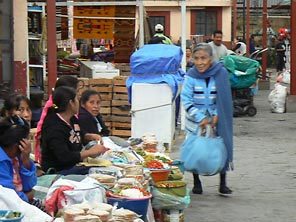
Right:
Gringos and locals shop for staples at the Mercado Ignacio Ramírez, where vendors sell fresh fruits and vegetables, tacos and homemade salsas
There's wireless Internet and cable television. A computer phone system called Vonage lets people keep their U.S. numbers, and make and receive calls with no long-distance charges.
The local Costco carries Kirkland-brand wild Alaskan salmon. Block-watch programs keep the crime rate lower than in many U.S. cities. A private postal service assigns people a mailing address in Loredo, Texas, then trucks the mail across the border so letters arrive in two days.
"San Miguel has changed tremendously in the past six years," says Judith Gill, a founder of City People's Mercantile stores in Seattle. In 2002, 29 years after attending art school in San Miguel, Gill returned and bought a furnished house for $200,000 in a Mexican neighborhood where chickens and roosters still wander the streets.
The house has doubled in value, and about half her neighbors are gringos. To an outsider, it sometimes looks as if every other person walking in El Centro is a foreigner, yet ex-pats number just 10 percent of San Miguel's 100,000 residents.
"You can be in San Miguel," says Gill, "and still have a sense that you're very much a minority, which you are."
IT TAKES Gordon Logan just 10 minutes to drive his Chevy to the "other San Miguel," a dusty village a few miles out of El Centro where he joins volunteers for Casita Linda — the Mexican version of Habitat for Humanity — building a home for a family living next door in a lean-to made from scraps of tin and
metal.
 Left:
Gordon Logan, center, works on the roof of a new house that volunteers are building for the Ramírez family as Ana Maria Juarez makes tortillas outside the tin and metal shack where the family lives. Many villages just a few miles away from San Miguel's historical center lack running water and electricity. Left:
Gordon Logan, center, works on the roof of a new house that volunteers are building for the Ramírez family as Ana Maria Juarez makes tortillas outside the tin and metal shack where the family lives. Many villages just a few miles away from San Miguel's historical center lack running water and electricity.
"The municipality of San Miguel has 531 villages in it, and those villages out there . . . one half of them don't have water," says Muriel Logan, 60, a former international human-resources coordinator with the Christian relief organization World Concern. "Most of them have no electricity. They have nothing."
It's not the San Miguel travel magazines splash on their covers, but for retirees with time to spare, it translates into dozens of volunteer opportunities, from working on environmental projects to teaching English.
Settled into their jobs and living in a Craftsman-style bungalow in Seattle's Montlake neighborhood, the Logans hadn't given much thought to Mexico as a place to live.
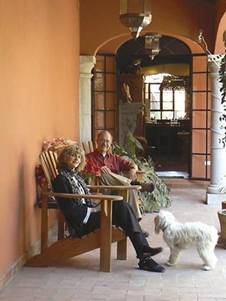 Right:
Muriel and Gordon Logan sold their Craftsman-style bungalow in Seattle's Montlake neighborhood and rebuilt a run-down house into an airy, two-story retreat in the
San Antonio neighborhood of San Miguel. Charity work and a Bible-study group keep them busy Right:
Muriel and Gordon Logan sold their Craftsman-style bungalow in Seattle's Montlake neighborhood and rebuilt a run-down house into an airy, two-story retreat in the
San Antonio neighborhood of San Miguel. Charity work and a Bible-study group keep them busy
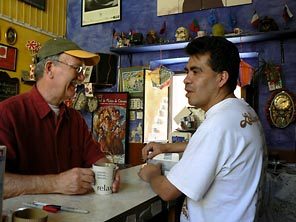
Left: Many businesses in San Miguel cater to the town's large ex-pat community. Logan, a former commercial property manager in Seattle, chats with Juan Ortiz at the Cafe Etc., where Logan is a regular customer.
"We weren't talking about retirement at all," recalls Muriel Logan. Then shortly after they got home from a vacation to San Miguel in 2001, Gordon lost his job as a commercial property manager.
"The choice was to either try and find another job in a down market or retire," he says. "We talked to a number of advisers, and the final decision was that it would be better if we had more money, but we could probably do it with what we had . . . in Mexico."
Muriel Logan, a gourmet cook, writer and linguist, pictured them someday settling in Europe or even Tunisia, where she spent a summer studying Arabic.
"When he said 'Mexico,' I said, 'I don't know about San Miguel.' I've always lived near the water . . . I wasn't sure this is where we needed to be."
Nearly six years later, they're certain it is. They transformed a run-down house into an airy, two-story retreat with a gas fireplace, an open-air patio with an arched portico, a kitchen decorated with handcrafted tiles and a guest cottage — all for $160,000, including the land. Charity work and a Bible-study group keep them busy, and they both have new part-time careers. He parlayed his experience in real estate into a construction consulting business. She's started an online hospitality and home-exchange business.
Like the Camps, they wrestle with the decision about how to pay for medical care. They dropped their Blue Cross insurance after Muriel had a hip replacement three years ago. Now they basically pay out of pocket, with the exception of a $2,000-a-year catastrophic policy on Gordon, 62. "We had two main options, one to go to the States and pay the deductible and the co-payments or have it done in Queretero (a town nearby) by a German surgeon there who's done 4,500 hip replacements and has his own clinic," Muriel recalls.
"Looking at the costs, we decided it would be much less expensive to have it done here, and pay for it straight." The bill, written on the back of a piece of paper and handed to them when they left the clinic, came to $8,000 for everything.
"THERE ARE complex reasons people choose to make their home outside the United States," says Margo Lane, 66. Not all of them are economic.
A grandmother of two and a former bank executive, she drew on her travel experiences to prepare her for her ultimate adventure, a decision stoked by a post-divorce solo backpacking trip in the Middle East and Southeast Asia.
Sometime in the early '90s, around the time George Bush Sr. was elected and the banking industry was in upheaval, she remembers saying to herself, "I don't want to live here anymore."
On the recommendation of George Little and David Lewis, her neighbors on Bainbridge Island where she owned a condo, she came to San Miguel for the first time in April 2006. Four days later, she bought a house under construction in a neighborhood of modest bungalows built 30 years ago as subsidized housing for teachers.
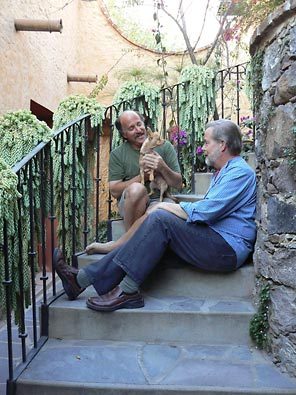
Left:
Landscape designers and artists David Lewis, left, and George Little of Bainbridge Island started coming to San Miguel in the mid-1990s. They recently purchased their second house here. The arts-centered lifestyle, Lewis says, "reminds me very much of when I was in college.''
Making the long drive to Mexico in her Prius with her dog, Teva, two months later, she pulled in late at night expecting to see a finished home. Instead, she found construction workers camped out in the living room. With no place to go because the hotels and B&Bs wouldn't allow her 70-pound dog, she spent her first night in the house with the workers.
Two weeks later, she moved in, but went three months without a kitchen. Later, she became ill and lost 18 pounds. It turned out that her water-filtering system had been installed backward. "I was drinking water straight out of the tap."
Margo Lane will tell you that Mexico is not Disneyland. But after two years here, she says she wakes up every morning smiling.
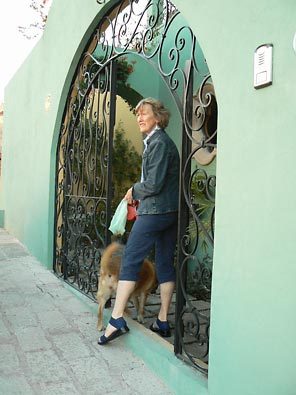
Right: Former Bainbridge Island resident Margo Lane has settled into her three-bedroom home in a San Miguel neighborhood of mostly Mexican families. She initially faced daunting construction problems and went three months without a kitchen. Now, she wakes up every morning smiling.
Maybe it's the weather, or her classes in photography and Spanish, or just the energy she feels as she walks through the Jardín on Saturday nights listening to the mariachi music. Settled into her neighborhood of mostly Mexican families, she lives comfortably in a three-bedroom house, painted mint green, with a fountain gurgling in the courtyard and a sunny rooftop deck.
Her "safety net" is a group of six American women who keep each other's keys and check in on each other, but she has friends of all ages. One is a 91-year-old neighbor who plays golf four times a week.
A highlight was spending her first Christmas Eve in San Miguel with the family of the Mexican man who helped her find her house.
With a daughter in the San Francisco Bay Area and a son in Kirkland, she's grown to think of "home" as the place where she feels warm, happy and safe.
"I felt it was home from the day I arrived," she says. "My country will always be the U.S., but my home is San
Miguel."
More Information on US Elder Rights Issues
Copyright © Global Action on Aging
Terms of Use |
Privacy Policy | Contact
Us
|



